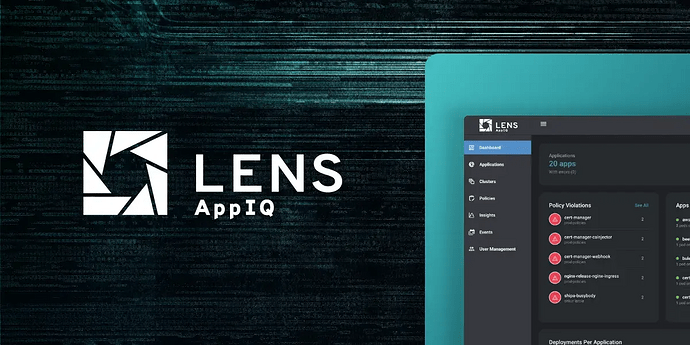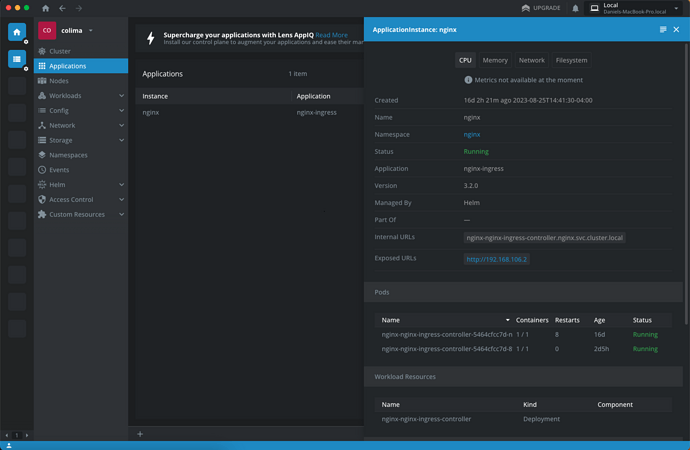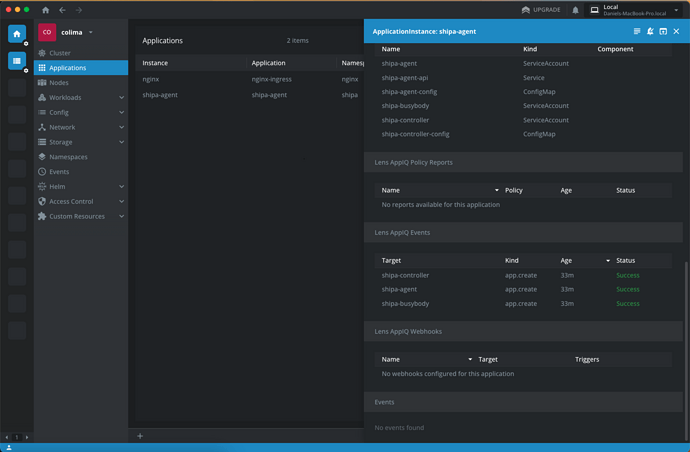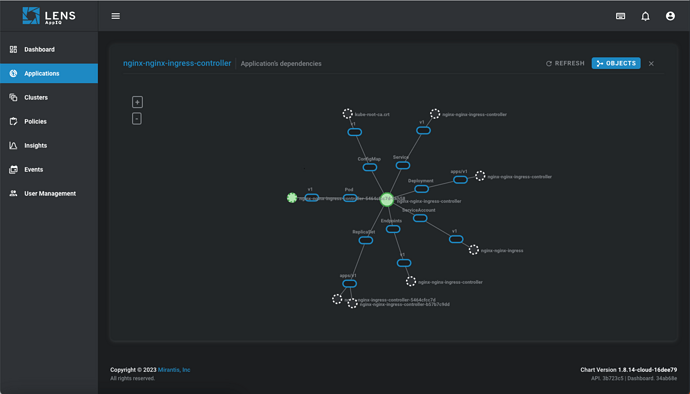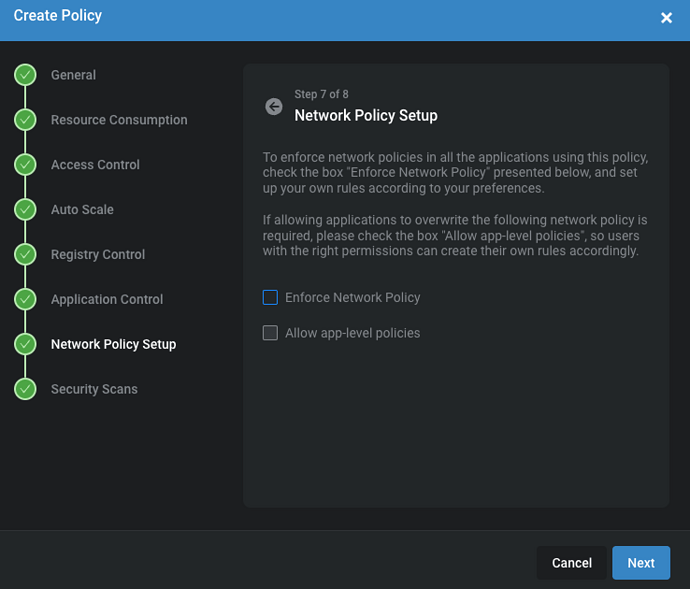Lens AppIQ – introduced today – is a SaaS service, instantly accessible within Lens Desktop to over 50,000 organizations currently using our Kubernetes IDE. Lens AppIQ provides web-based tools to help cloud-native developers onboard, build, deploy, troubleshoot, as well as policy-manage and monitor applications for security and compliance – doing all this quite simply, enabling high focus and efficiency.
To understand how Lens AppIQ fits in the Lens ecosystem, it helps to start by looking at the new Lens Application View, which shows rich views of everything relevant to each running application instance in a cluster.
Think of Lens Applications as your centralized command center for application health, performance, and security. Once you connect to a cluster, you can find Applications at the top level of the menu. Click to see a list of running application instances, then click again to see relevant information such as application metadata, status, metrics, relationships, internal or external URLs, pods, resources, vulnerabilities, and events.
Lens Application View makes application-focused developers’ lives easier – letting them concentrate on building instead of platform details. However, deploying and operating those applications in a secure and compliant way that respects your organization’s governance policies can be challenging.
Introducing Lens AppIQ
Lens AppIQ is a SaaS service that leverages an agent that runs on a Kubernetes cluster. The agent provides application intelligence: it interrogates configurations, maps all your applications, and reports securely on all this to the cloud service – where you and invited team members can view and work with the information. Developers can view application-centric information through the Lens Desktop Applications view or a browser. DevOps get additional webUI features to manage policies and deployment, or they can use a command-line.
Installing the agent in a connected cluster can be done from inside Lens Applications or by command line. Please visit Lens AppIQ to create an account.
Enriched Application-Centric Views
Once Lens AppIQ’s agent is installed in your cluster, it takes a few moments to map your applications. Thereafter, Lens Applications displays your views enriched with additional information, including real-time application metrics and notice of policy violations.
You can also visit the Lens AppIQ webUI to invite colleagues. Once they respond to invitations, team members can see similar application-centric views using a browser.
This gives teams efficient new options for organizing work by giving developers what they need to focus on building and updating applications. Whether accessed through Lens Desktop or the web UI, Lens AppIQ gives developers one, shared view for building and troubleshooting, for optimizing application performance, and for responding quickly and confidently to issues.
Policy Management, Monitoring and Alerting
Lens AppIQ allows DevOps to define, review, monitor, report on, and even enforce application policies. Simple web dialogs let you create policies identifying, for example, which registries are approved for sourcing containers, pod security, and many other parameters. Once defined, Lens AppIQ watches and can immediately notify violations through systems like PagerDuty and Slack giving teams a line of defense against bad practices and errors, and providing a strong framework for security and compliance. Lens AppIQ can also generate reports on policy violations, as an aid to security audits and compliance due-diligence.
Simplified Application Deployment
Finally, Lens AppIQ can integrate with authorized registries to deploy updates to pre-built container workloads with a button-press. And it can even integrate with authorized repos to build and deploy whole applications, using Cloud Native Buildpacks. Lens AppIQ can even deploy an application from bare containers – generating all the required Kubernetes objects in the process. This gives teams new options for deploying apps in standardized ways, across multiple clouds.
Lens AppIQ deployment includes both CVE and policy scanning during the deploy/update cycle, and can be configured to prevent execution of workloads that violate defined policies (e.g., too many CVEs). So you get rapid, simple updates to running applications, and a simple, dependable secure software supply chain.
Get Started With Lens AppIQ!
Lens AppIQ is now easier than ever to try out. Here are your options:
- Directly from Lens Desktop: If you’re already using Lens Desktop, you can seamlessly install Lens AppIQ without leaving the interface.
- Web Interface: Visit the Lens AppIQ web portal to create an account. If you don’t have a Lens ID, you’ll get one in the process. We highly recommend that you also download Lens Desktop, as the two services are most powerful when used together.
Pricing Plans
- Free Forever Plan: Ideal for individuals and small teams, this plan supports up to 10 nodes, 2 Kubernetes clusters, and 2 users.
- Pro Plan: Designed for larger organizations, this fully-supported plan offers enhanced capabilities.
For more detailed information, consult our Lens AppIQ Documentation.We value your feedback! Please let us know what you think of Lens AppIQ.
About Lens
Lens is the way the world runs Kubernetes. It’s lowering the barrier of entry for people just getting started and radically improving productivity for people with more experience. Users of Lens gain clarity on how their clusters and cloud native software stacks work. It helps people to put things in perspective and to make sense of it all.
Tens-of-thousands of businesses and hundreds of thousands of users develop and operate their cloud native workloads on Lens. It is built on open source, has 20.6k stars on GitHub, and is backed by a number of Kubernetes and cloud-native ecosystem pioneers. Lens is the largest and most advanced Kubernetes platform in the world.
Learn more about Lens in our documentation.
